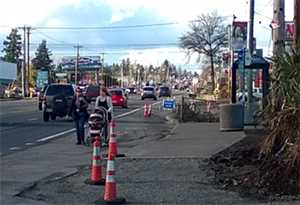HIA Stories from the Field
Clackamas County: Oregon Health Authority
Health Impact Assessment in Transportation Planning

It’s more than Safety
Southeast McLoughlin Boulevard (Oregon 99E), in the northwestern corner of Oregon’s Clackamas County, was designed primarily for motor vehicle traffic rather than pedestrian traffic to its auto-oriented businesses and shopping areas. McLoughlin Boulevard can be an unsafe and inhospitable environment for pedestrians and bicyclists. Not surprisingly, the local population has higher-than-county-average rates of four key transportation-related health outcomes: asthma, diabetes, heart disease, and obesity.
In January, 2014, Clackamas County Public Health Division partnered with the Clackamas County Department of Transportation and Development, and the Oregon Public Health Institute, an independent, non-governmental, not-for-profit entity, to conduct a Health Impact Assessment of the “Active Transportation Road Safety Audit” that was being conducted on a section of McLoughlin Boulevard. County public health staff looked at opportunities for physical activity; exposure to air and noise pollutants; and access to health supportive resources, such as healthy food, clinical healthcare, social services, parks, trails, recreation facilities, and gathering spaces.
Focus on Capacity Building
Public health professionals, planning professionals, engineers, and members of the local community collaborated on key issues such as health, community, and livability, affected populations, and methods, with input from as many participants as possible. Public Health experts helped identify all potential direct and indirect health impacts, with community and stakeholder input to help determine which impacts were most relevant.
The Health Impact Assessment focused on 42 Road Safety Audit [PDF - 1.25 MB] recommendations according to their relative impacts on the chosen health determinants. Thirty-six out of the 42 Road Safety Audit recommendations positively impacted physical activity, exposure to noise and air pollution, and access to resources. The recommendations with the highest degree of impact were building sidewalks and filling sidewalk gaps, improving lighting and providing crossing enhancements to increase visibility and attract pedestrians
There were challenges during the Health Impact Assessment. The 42 proposed recommendations were difficult to differentiate, and there was limited time and money to address them all. Andrea Hamberg, the Health Impact Assessment Program Coordinator at the Oregon Health Authority emphasized that Health Impact Assessments are “sizeable and flexible.” She stressed the importance of considering a Health Impact Assessment early in a project. “Health Impact Assessments aren’t one-size fits all. It is a flexible framework that allows for the consideration of public health data and public health resources in an ongoing or current decision making process so that we are better stewards of our community health and expenditures.”
Prevention is Cost Effective
“According to CDC, each year Oregon spends $411 million on asthma, $1.9 billion on cancer, $892 million on depression, $1.7 billion on diabetes, and $3.6 billion on cardiovascular and other preventable diseases including stroke and hypertension. Approximately 35% of that is paid by taxpayers to state and federal Medicare and Medicaid programs,” she says. “We could improve quality of life and reduce taxpayer burden by reducing preventable diseases now. When working with a group of professionals who never thought their work impacted public health, and who are not routinely engaged in public health, they get it. Some come up with solutions public health hasn’t considered yet. From a public health standpoint, prevention is the most cost effective tool we have.”
Additional Resources
- How to initiate a Health Impact Assessment in your area
- National Health Expenditure Data Fact Sheet (2013)
- Oregon’s Health Impact Assessments, “Working towards healthier projects and policies”
- SE McLoughlin Blvd (Oregon 99E) Active Transportation Road Audit/Health Impact Assessment [PDF - 656 KB]
- Page last reviewed: May 27, 2015
- Page last updated: May 27, 2015
- Content source:


 ShareCompartir
ShareCompartir